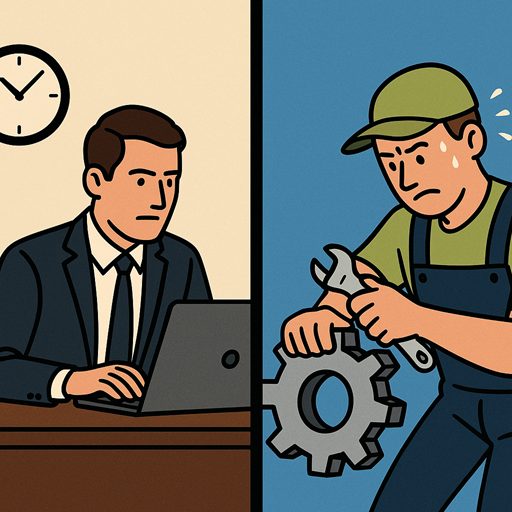Blue-collar vs white-collar: Two Worlds of Work and Their Consequences
Blue-collar vs white-collar – these two English phrases increasingly dominate discussions about the labor market, representing the contrast between manual labor and office-based work. For employees in the e-commerce sector (e.g., Allegro, CCC), this division may feel abstract, yet in reality, it affects core aspects of our physical and mental wellbeing. In this article, we explore the cultural, physical, and psychological differences between these working styles – and what they mean for our bodies, minds, and private lives.
The origin of the division and embedded stereotypes
The terms white-collar and blue-collar originated in the early 20th century, when office workers typically wore white shirts, and manual laborers wore durable blue denim uniforms to hide dirt. Over time, this visual distinction became a cultural one. Media and advertising helped cement the stereotype: the white-collar worker – well-dressed, working in a climate-controlled office; the blue-collar worker – tough, practical, in high-vis gear or overalls.
Though simplistic, the divide still shapes our thinking. In one frame: executives, spreadsheets, marketing decks. In the other: tools, machines, steel-toe boots. Each world has its own demands, rhythms, and risks – both essential to the functioning of society.
The physical toll of labor
Manual labor (blue-collar) often involves heavy lifting, repetitive motion, or working with machinery. Studies show that these conditions lead to chronic pain, injuries, and long-term joint problems. Prolonged strain can trigger back pain, knee damage, or shoulder inflammation – even with protective gear.
At first glance, white-collar work seems safer. But sitting all day comes with its own dangers. Scientific data shows that those who sit more than eight hours a day are up to 60% more likely to die prematurely than more active counterparts. In Poland, nearly 70% of working adults sit for most of their working hours. Sedentary life contributes to obesity, poor posture, and cardiovascular risk – even in a seemingly cushy job.
And then there are ergonomic issues: staring at screens, hunched over desks, tech-neck, and eyestrain. Many office workers experience chronic discomfort after years of work – yet few recognize these issues as “occupational hazards.” The body was not designed for 10 hours of email per day.
The mental overload of white-collar work
White-collar roles come with an entirely different set of stressors – namely, mental fatigue and informational overload. The average knowledge worker is bombarded with emails, Slack messages, Zoom calls, and tight deadlines. This leads to what researchers now call “infobesity” – a constant flood of information that triggers anxiety, impairs focus, and depletes decision-making abilities.
Digital fatigue is another growing issue. Since the pandemic, exposure to screens has skyrocketed. A 2023 EY report found that 47% of office employees experience such intense digital fatigue they must consciously take screen breaks. One in four plans to reduce the number of platforms and devices they use. Blue light, app notifications, and asynchronous work cycles all disrupt our natural circadian rhythm, contributing to insomnia and long-term exhaustion.
Meanwhile, blue-collar workers face stress of a different kind: environmental noise, time pressure, physical wear. The saving grace? A clearer boundary between work and rest. When the shift ends, they clock out. White-collar work often bleeds into evenings, weekends, and even vacations.
What happens after work matters just as much
Regardless of which side of the blue-collar vs white-collar divide you’re on, the way we recover matters. If you can’t control your work format, try to balance the deficit at home.
For those behind desks all day, physical activity becomes essential. Even short breaks – a walk, stretching, taking the stairs – can reduce muscle tension and improve circulation. Gardening, DIY projects, or cooking are all ways to restore bodily rhythm after hours of intellectual work.
If you’re physically drained from manual labor, mental rest is key. Reading, music, mindfulness, or even a quiet evening with no screens can help restore clarity and reduce cortisol.

And there’s one more powerful tool: repetitive, manual domestic tasks – like washing dishes by hand. Believe it or not, a study found that students who mindfully washed dishes experienced a measurable drop in stress and increase in inspiration. Cleaning, ironing, or organizing can offer calm – as long as it’s intentional and not rushed.
Gardening, in particular, has proven therapeutic effects. Studies show that contact with plants can reduce cortisol levels by up to 30%, while improving overall mood. This form of “grounding” helps the brain shift from reactive to reflective mode – and that alone is a win in a hyperstimulated world.
Final thoughts
The blue-collar vs white-collar distinction highlights the unequal distribution of stress, movement, and mental load in today’s workforce. But it doesn’t need to be a competition. Each side faces its own burdens – whether it’s worn knees or a burned-out brain.
What matters is recognizing your personal imbalance – and taking small, intentional steps to correct it. If your job wears out your body, nourish your mind. If your job taxes your mind, move your body. And no matter your role, create a buffer between work and life – a ritual, a habit, a practice that anchors you.